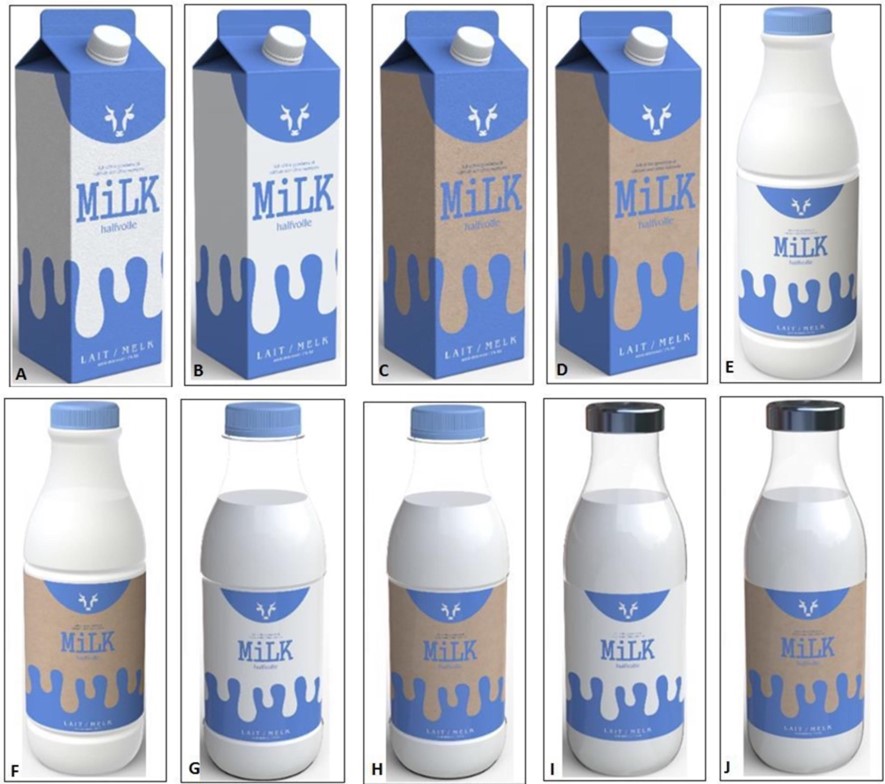Don’t cry over spilled milk; the wastefulness perception of various beverage packaging
Relevant topics Research, Archive
Sustainability is become a more important brand asset with the years. Additionally, the majority of consumers have the intention to pay more for environmentally sustainable packaging (Popovic et al., 2020). However, consumers often don’t know what sustainable packaging should look like (Boz et al., 2020). Mostly, consumers categorize packaging in one of three categories: recyclable, re-usable or wasteful.
Let’s put it to the test! How do you like your milk?
Do you know what makes a sustainable packaging? Is a glass bottle of milk a sustainable packaging? And what about a plastic jug of milk? And what about carton milk boxes?
A common misunderstanding is the belief that glass is sustainable because it can be recycled. And plastic is less sustainable. However, according to the Life Cycle Analysis glass is one of the least sustainable options available because of the energy that is required for production, transport, and recycling. The sustainability of plastic however is commonly underestimated. The opposite holds true for carton milk boxes: they are often thought to be more sustainable than plastic. But because they consist of a composite of materials, they are not well recycled and thereby have a slightly higher impact than the plastic milk jugs.
This example painfully shows that consumers are often ill-informed of the real sustainability of packaging. Therefore, visual cues on product packaging may be a viable option to assist consumers in sustainable decision making.
What makes a product packaging sustainable?
There are several aspects on the packaging that could serve as these visual cues. For example, as we wrote earlier, a product is perceived more sustainable when it’s displayed without any packaging. When a product needs to be packaged, colors can be considered as well. Mostly the color green is the first option that comes to mind in communicating sustainability. However, in a previous blog we showed that while this activates associations of eco-friendliness, white colored packaging was most successful in increasing willingness to pay for these products.
To find the distribution of which visual cues are most important, Liem et al. (2022) designed ten milk package designs which differed in color, shape and material. Packages varied in shape (carton, bottle), material (carton, plastic, transparent glass), colors (white or cardboard brown which is thought to be natural looking) and texture (smooth or rough as cardboard structure), see also the figure.

Drum roll!
The results revealed that consumers’ perception of sustainability was mostly driven by their belief whether a packaging is recyclable and/or reusable.
Indeed, the qualitative part of this study re-established that most consumers associated carton packaging with sustainability. In a discussion group, several respondents perceived the glass packaging as very sustainable. Subjects expected plastic hard to recycle, which made it in their view less sustainable. Subjects in this study were more considerate of the composite of materials than previous studies: in their view the ability to re-use or recycle the packaging was often negatively impacted by the variety of materials which were used in a particular packaging format, which was most often mentioned with regards to the carton packages.
In the quantitative part of the study, only four packages were incorporated: milk boxes that varied in color (white or cardboard brown) and texture (smooth or cardboard structure). The perception of sustainability was significantly influenced by described texture, as well as color. This means that the cardboard structures evoked higher sustainability ratings compared to the smooth textures, as well as the brown cardboard color when compared to the white one. There was no effect of these packages on expected taste or health of the product.
Yeah but, color does not influence ME.
The qualitative results showed that consumers were considerate that the composite packaging of carton milk boxes may be less sustainable. But the quantitative results still indicated that they thought cardboard looking packages were the most sustainable. This discrepancy implies that the effect of cardboard looking packaging is more implicit. Interestingly, this was underlined when subjects were asked whether their sustainability ratings would be influenced by coloured labels. Most of them denied that colour impacted their perception of sustainability! But as the results showed, color clearly impacted their choices.
And it's not only sustainability that implicitly impacts the consumers perception of a packaging. In a previous article, we already explained that packaging shapes and colors may also impact the implicit taste perceptions of the product.
Only cardboard when you’re green!
This clearly implicates that consumers are easily fooled by the color of the carton milk boxes that falsely convey sustainability. This could lead to the practical implication that all beverages should be packed in cardboard looking packaging in order to meet the sustainability wishes of consumers.
Communicating sustainability when the product (packaging) is not, this is called greenwashing. And next to morality, greenwashing can also have negative effects. The inconsistency between a (falsely) green attribute of a product (packaging) and the accompanied higher price may have a negative effect on the consumer, as we summarized in an earlier publication. So, when communicating your sustainable brand assets, please make sure they truly are green.
And what about green consumers?
Another research team by Ischen et al. (2022) was also interested in the cardboard look of milk packaging. They were able to replicate the finding that cardboard material signals environmental friendliness to the consumers. Moreover, they showed that explicit sustainability cues such as ecolabels positively impacted the sustainability perception.
Interestingly, there was no difference in environmental engagement between the subjects: subjects that labelled themselves as environmental and green were equally impacted by the cardboard and ecolabels as non-green consumers in rating the sustainability of the milk packaging.
Additionally, the communication of environmental friendliness by the implicit cue of color and explicit cue of ecolabels both increased the salience of the packaging. Thus, it’s not only beneficial for the planet if you’re truly sustainable, but it might also be beneficial for the attention your product packaging grabs as well!
Conclusion
Thus, visible carboard texture in combination with cardboard color was most effective in raising consumers’ perception of sustainability. Important to note here is that this did not reflect the true nature of the packaging! Due to the composite of materials in carton milk boxes, plastic might be a more sustainable option. Consumers are starting to become considerate of this fact when asked specifically, but do not show it in their sustainability ratings.
Further Reading
-
How brand stories on packaging influence consumer behavior and purchase intent
Once upon a time, our ancestors would gather around a fire to tell stories, sharing their imaginations and lessons with others. Fast-forward to today and we are still sharing stories, but accompanied by smartphones instead of fires.
-
A Surprisingly Simple Way To Make Food Packaging More Appealing
In their battle for customer attention, food packaging designers are eager to implement techniques from psychology. It gives them an edge over their competitors in grabbing customer attention and increasing sales.
Especially in the aisles containing your typical vice products, most purchases are unplanned. This leaves a major role for on-pack visuals and claims to determine which products end up in our shopping baskets.
Over the years, consumer psychologists have unearthed many of these design techniques, which are often quite eloquent and subtle, such as:
- Getting the typography right (did you know that round fonts reinforce our perception of sweetness?)
- Cleverly arranging the various visual elements (did you know that bottom-heavy pack designs increases our perception of the amount of product we’ll be getting)
- Using nature’s principles of beauty (did you know that designs following the golden ratio are regarded more beautiful?)
As we focus on ever-more subtle design techniques, we may be overlooking the most powerful weapons of influence that are in front of our faces all along. A recent study by Huang et al., (2022) has thrown the spotlight on one such factors: image size.



